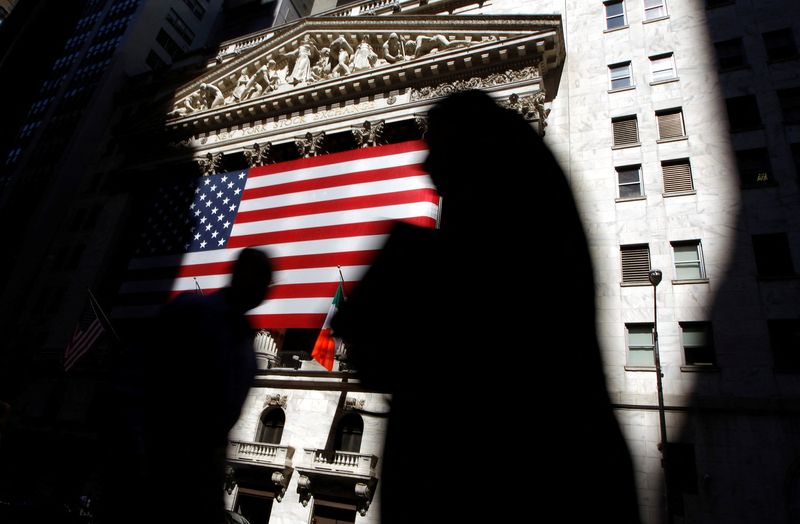This post was originally published on this site

1. Futures point lower
U.S. stock futures edged lower on Monday, as investors kept an eye on signs of a prolonged elevation in interest rates that have weighed on Wall Street throughout September.
At 05:05 ET (09:05 GMT), the Dow futures contract had dipped by 57 points or 0.2%, S&P 500 futures slipped by 8 points or 0.2%, and Nasdaq 100 futures fell by 34 points or 0.2%.
The Federal Reserve suggested last week that borrowing costs will need to remain higher for a longer period of time, placing upward pressure on bond yields and dampening stocks. Equity markets have also been contending with a surge in oil prices and renewed strength in the U.S. dollar.
Entering the final week of trading in September, the benchmark S&P 500 is down 4.2% for the month, the tech-heavy Nasdaq Composite has slid by 5.9% and the 30-stock Dow Jones Industrial Average has shed 2.2%.
2. Crucial week in U.S. budget stand-off begins
U.S. lawmakers are attempting to find a resolution to an ongoing budget stand-off ahead of October 1, when the federal government is set to run out of funding for its operations.
Over the weekend, Democrats and Republicans in Congress both warned that there is a chance a deal will not be reached. However, House Speaker Kevin McCarthy, a leading GOP figure, has remained hopeful that a shutdown could be avoided.
McCarthy has faced internal opposition from conservative holdouts over taxing and spending, including on support for Ukraine. A plan to create a 45-day extension to government funding to give legislators more time to hash out an agreement has also come up against strong resistance.
Washington’s latest budgetary showdown comes only a few months after a battle over the U.S. debt limit almost brought the world’s largest economy to the brink of a damaging default. Hardline Republicans and allies to former president Donald Trump have voiced their disapproval of the outcome of the debt-ceiling fight, suggesting that they are even less likely to back a new fiscal agreement.
3. Tentative deal to end Hollywood writers’ strike reached
The union representing Hollywood writers, as well as major studios, and streaming services announced on Sunday that they hashed out a deal to end a monthslong strike.
According to unnamed sources cited by the Wall Street Journal, the three-year agreement will include increased royalties for writers and protections regarding the use of artificial intelligence.
Although the details of the accord have yet to be divulged, the Writers Guild of America has said the preliminary deal was “exceptional” and delivered “meaningful gains” for its members. The WGA’s membership must still ratify the agreement before the strike is formally concluded.
Meanwhile, the WGA encouraged its members to stand with the actors’ union, SAG-AFTRA, which has seen talks with studios and streaming companies stall. Hollywood executives, however, are optimistic that the breakthrough in the WGA negotiations may help forge a path ahead for a potential deal with SAG-AFTRA.
4. Amazon’s (NASDAQ:AMZN) $4 billion Anthropic investment
Amazon said on Monday that it is aiming to invest up to $4 billion in artificial intelligence group Anthropic, as the tech giant looks to bolster its position in the corporate arms race over nascent AI technology.
Under the terms of the agreement, Amazon will place an intial investment of $1.25B in Anthropic for a minority stake in the rival to ChatGPT-maker OpenAI. Anthropic will then have access to Amazon’s cloud computing platform to help optimize its AI systems, known as large language models.
Anthropic garnered a valuation of almost $5B in its last funding round earlier this year, the Financial Times reported, citing a source familiar with the matter.
The move is the latest sign that Amazon, one of the technology sector’s biggest players, is becoming increasingly focused on building out its generative AI offerings. Along with Anthropic’s chatbot, Amazon is also trying to brand its Inferentia and Trainium AI chips as possible alternatives to popular processors made by Nvidia (NASDAQ:NVDA).
5. Crude inches higher after negative week
Oil prices moved higher on Monday, rebounding after their first negative week in four as traders returned their focus to the prospect of tighter supplies over the rest of the year.
Both contracts fell last week after the hawkish policy update from Federal Reserve raised concerns of a hit to U.S. economic activity and, in turn, oil demand in the world’s largest oil consumer.
But prices remain near their highest levels since November last year on forecasts of a wide crude supply deficit in the fourth quarter in the wake of Saudi Arabia and Russia extending additional supply cuts to the end of 2023.
By 05:07 ET, the U.S. crude futures traded 0.4% higher at $90.38 a barrel, while the Brent contract climbed 0.3% to $92.24 per barrel.

